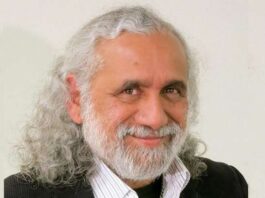Novel: Tamas by Bhisham Sahni. First published in 1973. Subject: Partition riots
Daisy Rockwell, translator of the 2016 edition of Sahni’s novel Tamas, calls the novel the anatomy of a ‘riot’. She says,
Structurally, it is a highly unusual work, with no clear human protagonist…. [T]he real protagonist of Tamas is not a person at all, but the riot itself.
No one knows about the originator of the whole farce, the hand that set in motion the senselessness. But then massacres may not have one clear cause. Murad Ali, who paid Nathu to kill the pig, is a phantom figure; Nathu at one point argues with himself whether he had actually seen him or Murad Ali was merely a figment of his imagination. The riot in the novel seems to have an independent existence of its own. It seems to act on the psyches of the people. The cause is ambiguous. And yet many fingers point towards the English man.
Kundera asserts that a person can be explained in a metaphor. Believing his word are true for novels also, the story can be contained in the image of Nathu standing in the middle of the room, staring into the red eyes of the pig he is about to slaughter. The opening presages the violence ensuing from the slaughter of the pig. Using a harmless animal to incite bloodshed is comically ironic. This confused state of affairs plunges us headlong into chaos. Violence takes hold of the minds of people in such a way as makes the uninitiated like Runveer a devout worshipper of the Blood Goddess. Episodes like this and Shahnawaz’s pushing the Hindu servant off the staircase are reminiscent of Golding’s Lord of the Flies. Man turns on man and childhood friends are at each others’ throats. As Forster would say, ‘It is a muddle’.
Richard, the deputy commissioner, is the typical English breed. Not only is he intent upon gaining physical control over the people, he also knows how this control can be consolidated by manipulating their minds and altering their history. He makes a revealing comment to his wife.
یہاں لوگ کچھ نہیں جانتے ہیں۔ یہ وہ ہی جانتے ہیں جو ہم انہیں بتاتے ہیں۔ یہ لوگ اپنی تاریخ کو نہیں جانتے۔ بس اس کا نام لیتے ہیں۔
There is a clear difference between knowing your history and living it. Hindustan breathes in the plethora of its castes, religions, languages, colours, the hundred iridescent eyes on the feathers of a peacock. The White man, however, is nowhere in the action, yet he is ubiquitous, pulling the strings unseen. His presence is felt in his absence.
Like any great writer and an observer of human life, Sahni does not take sides. His view of life is not wholly pessimistic, as might appear at first. Man is a curious mix of grandeur and downright idiocy. While we see the depths of human cruelty on one hand, in characters like Rajo, the Muslim woman who gives shelter to an old Sikh couple, Sahni has showed the heights to which human beings can soar.
- Tamas (Darkness) - 08/09/2021





